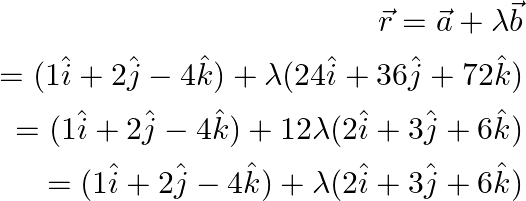Solution:
The vector eq. of a line passing through a point with position vector ![]() and parallel to a vector
and parallel to a vector ![]() is
is ![]()
Given: the line passes through ![]()
Therefore,
![]()
Also given that, line is parallel to both planes.
Therefore it can be said that the line is perpendicular to normal of both planes.
That is ![]() is perpendicular to normal of both planes.
is perpendicular to normal of both planes.
It is known that
![]() is perpendicular to both
is perpendicular to both ![]()
Therefore, ![]() is cross product of normal of planes
is cross product of normal of planes
![]() and
and ![]()
![Rendered by QuickLaTeX.com \begin{array}{l} \text { Required Normal }=\left|\begin{array}{ccc} \hat{i} & \hat{j} & \hat{k} \\ 3 & -16 & 7 \\ 3 & 8 & -5 \end{array}\right| \\ =\hat{i}[(-16)(-5)-8(7)]-\hat{j}[3(-5)-3(7)]+\hat{k}[3(8)-3(-16)] \\ =\hat{i}[80-56]-\hat{j}[-15-21]+\hat{k}[24+48] \\ =24 \hat{i}+36 \hat{j}+72 \hat{k} \end{array}](https://www.learnatnoon.com/s/wp-content/ql-cache/quicklatex.com-980d0a57f68c1820041387b3a9851852_l3.png)
So,
![]()
Substituting the value of ![]() in the formula, we obtain
in the formula, we obtain

As a result, the equation of the line is
![]()
